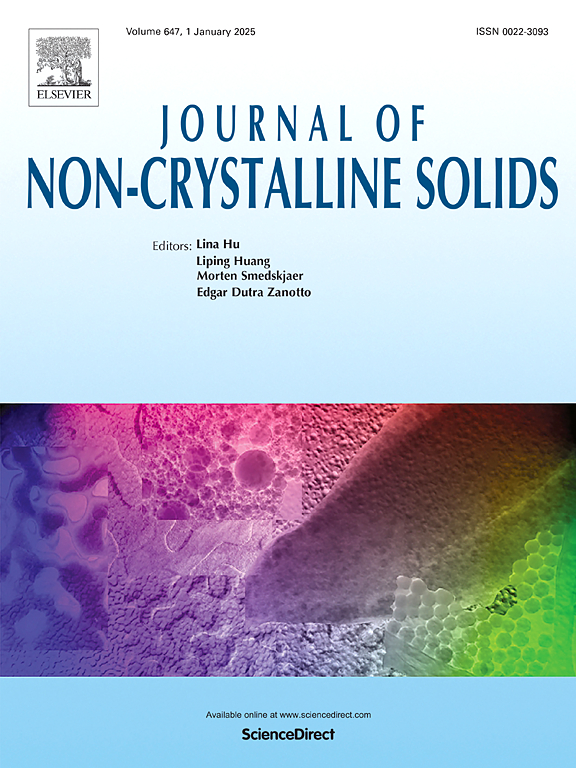Multi-objective optimization of Fe-based metallic glasses on magnetic property, thermal stability and glass forming ability
IF 3.2
3区 材料科学
Q1 MATERIALS SCIENCE, CERAMICS
引用次数: 0
Abstract
It is a great challenge to optimize the composition and improve the multi-properties of Fe-based metallic glasses (Fe-based MGs) by traditional trial-and-error method. Here, a strategy combining ensemble learning (EL) and non-dominated sorting genetic algorithm-III (NSGA-III) is proposed to efficiently design Fe-based MGs with simultaneous high magnetic property, thermal stability and glass-forming ability (GFA). With alloy compositions as the sole input, four EL models and three linear models are employed to predict saturated magnetic flux density (), onset crystallization temperature () and maximum casting diameter () of Fe-based MGs, respectively. Particle swarm optimization (PSO) algorithm is introduced to optimize hyperparameters of the models. It is found that the PSO-CatBoost model and PSO-ET models with different hyperparameters can better predict , and with higher accuracy. Further, the effects of key compositions on three properties are qualitatively analyzed based on SHAP analysis and correlation analysis. Finally, taking Fe–B–Si–P–C system as an example, multi-objective optimization based on NSGA-III is executed to obtain Pareto front and 15 Pareto-optimal solutions for three properties. When the is greater than 1.6 T, there are four alloys with and better than the raw data. At this time, increases by 5.02% to 8.07% and increases by 52.38% to 72.08%. It is also demonstrated that the sum of Fe and B content is the key factor affecting these three properties. This work provides an efficient strategy for developing new Fe-based MGs with better comprehensive performance.
铁基金属玻璃的磁性能、热稳定性和玻璃成形能力的多目标优化
通过传统的试错法来优化铁基金属玻璃的成分和提高其多种性能是一个巨大的挑战。本文提出了一种集成学习(EL)和非支配排序遗传算法- iii (NSGA-III)相结合的策略,以高效地设计同时具有高磁性、热稳定性和玻璃形成能力(GFA)的铁基mg。以合金成分为唯一输入,采用4种EL模型和3种线性模型分别预测了fe基mg合金的饱和磁通密度(Bs)、起始结晶温度(Tx)和最大铸造直径(Dmax)。引入粒子群算法对模型的超参数进行优化。发现不同超参数的PSO-CatBoost模型和PSO-ET模型能较好地预测b、Tx和Dmax,精度较高。基于SHAP分析和相关分析,定性分析了关键成分对三种性能的影响。最后,以Fe-B-Si-P-C体系为例,基于NSGA-III进行多目标优化,得到3个性质的Pareto前解和15个Pareto最优解。当Bs大于1.6 T时,有4种合金的Tx和Dmax均优于原始数据。此时Tx增加5.02%至8.07%,Dmax增加52.38%至72.08%。结果表明,铁、硼含量的总和是影响这三种性能的关键因素。这项工作为开发综合性能更好的新型铁基镁合金提供了一种有效的策略。
本文章由计算机程序翻译,如有差异,请以英文原文为准。
求助全文
约1分钟内获得全文
求助全文
来源期刊

Journal of Non-crystalline Solids
工程技术-材料科学:硅酸盐
CiteScore
6.50
自引率
11.40%
发文量
576
审稿时长
35 days
期刊介绍:
The Journal of Non-Crystalline Solids publishes review articles, research papers, and Letters to the Editor on amorphous and glassy materials, including inorganic, organic, polymeric, hybrid and metallic systems. Papers on partially glassy materials, such as glass-ceramics and glass-matrix composites, and papers involving the liquid state are also included in so far as the properties of the liquid are relevant for the formation of the solid.
In all cases the papers must demonstrate both novelty and importance to the field, by way of significant advances in understanding or application of non-crystalline solids; in the case of Letters, a compelling case must also be made for expedited handling.
 求助内容:
求助内容: 应助结果提醒方式:
应助结果提醒方式:


